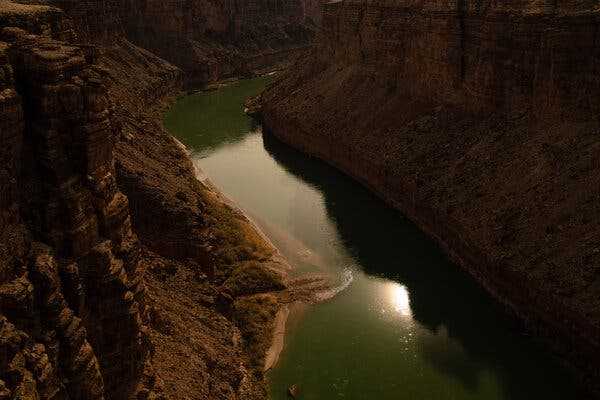The vote was 5 to 4, with the majority finding that an 1868 treaty did not require the federal government to ensure the tribe had access to water.
- Give this article

The case decided on Thursday centered on a dispute over access to the drought-depleted Colorado River system.
The Supreme Court ruled against the Navajo Nation on Thursday in a water rights case, rejecting the tribe’s suit against the federal government in a dispute over access to the drought-depleted Colorado River system.
The vote was 5 to 4, with Justice Brett M. Kavanaugh writing for the majority. He said the 1868 peace treaty at the heart of the case did not require the federal government to take “affirmative steps” to secure water for the Navajo.
In dissent, Justice Neil M. Gorsuch, joined by the court’s three liberal members, said the tribe’s request was more modest than that, adding that the government had violated the plain terms of the treaty and had given the tribe an epic runaround.
“To date, their efforts to find out what water rights the United States holds for them have produced an experience familiar to any American who has spent time at the Department of Motor Vehicles,” he wrote. “The Navajo have waited patiently for someone, anyone, to help them, only to be told (repeatedly) that they have been standing in the wrong line and must try another.”
He added that the runaround had persisted for decades: “When this routine first began in earnest, Elvis was still making his rounds on ‘The Ed Sullivan Show.’”
The Navajo Tribe is one of the largest in the United States, with more than 300,000 enrolled members, Justice Kavanaugh wrote. And its reservation, a product of the treaty, is the biggest in the nation, spanning more than 17 million acres in parts of Arizona, New Mexico and Utah. It is about the size of West Virginia.
In the arid West, Justice Kavanaugh wrote, “water has long been scarce, and the problem is getting worse.”
The tribe sued the federal government in 2003, seeking to compel it to assess the tribe’s needs and devise a plan to meet them. The states of Arizona, Colorado and Nevada intervened in the suit, seeking to protect their own access to water from the Colorado River system.
As Justice Kavanaugh framed the question in the case, the tribe sought to force the federal government to take concrete steps to obtain water for it.
“The Navajos do not contend that the United States has interfered with their access to water,” he wrote. “Rather, the Navajos argue that the United States must take affirmative steps to secure water for the tribe — for example, by assessing the tribe’s water needs, developing a plan to secure the needed water and potentially building pipelines, pumps, wells or other water infrastructure.”
The treaty, Justice Kavanaugh concluded, did not impose such an obligation.
“The historical record,” he wrote, “does not suggest that the United States agreed to undertake affirmative efforts to secure water for the Navajos — any more than the United States agreed to farm land, mine minerals, harvest timber, build roads or construct bridges on the reservation.”
The majority opinion was 13 pages and was joined by Chief Justice John G. Roberts Jr. and Justices Clarence Thomas, Samuel A. Alito Jr. and Amy Coney Barrett.
Justice Gorsuch’s dissent in the case, Arizona v. Navajo Nation, No. 21-1484, spanned 27 pages and said the majority had misunderstood history, the treaty and what the tribe sought.
The treaty, he wrote, promised the tribe that it could make the reservation its “permanent home.”
“As both parties surely would have recognized,” he wrote, “no people can make a permanent home without the ability to draw on adequate water.”
It followed, Justice Gorsuch wrote, that the federal government had undertaken at least some obligations.
“The Navajo have a simple ask: They want the United States to identify the water rights it holds for them,” he wrote. “And if the United States has misappropriated the Navajo’s water rights, the tribe asks it to formulate a plan to stop doing so prospectively.”
Justices Sonia Sotomayor, Elena Kagan and Ketanji Brown Jackson joined Justice Gorsuch’s dissent.
As Justice Kavanaugh summarized his majority opinion from the Supreme Court bench on Thursday morning, Justice Gorsuch looked forlorn. As the summary neared its conclusion, he bowed his head and closed his eyes.
Chris Cameron contributed reporting.
Adam Liptak covers the Supreme Court and writes Sidebar, a column on legal developments. A graduate of Yale Law School, he practiced law for 14 years before joining The Times in 2002. @adamliptak • Facebook
- Give this article
Source: nytimes.com



